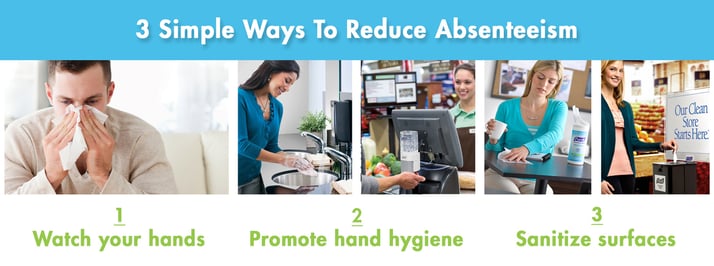
Proper Hand Hygiene is the Single Most Important Thing You Can Do For Your Health and the Health of Your Business
A recent study conducted by Medical Mutual of Ohio and GOJO Industries was the first to prove a direct link between the availability of a comprehensive hand hygiene program and a reduction in absenteeism and health care insurance claims1 tied to hand hygiene preventable illnesses. The study found that a comprehensive hand hygiene program not only reduced healthcare claims by over 24%, but also reduced absenteeism by over 13%.
According to the Centers for Disease Control and Prevention, the single most important thing we can do to prevent getting sick and spreading illness to others is to wash our hands. All workplaces, schools, health care facilities, food service establishments, office buildings — every business everywhere should make it as simple as possible for everyone to clean their hands.
3 Simple Ways To Prevent Spreading Germs and Reduce Absenteeism
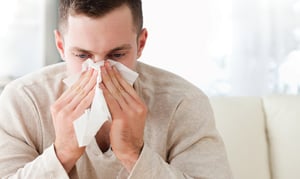 1) Watch your hands and be mindful of touching your eyes, nose, and mouth after touching high traffic surfaces and surfaces that may not be cleaned or sanitized on a regular basis.
1) Watch your hands and be mindful of touching your eyes, nose, and mouth after touching high traffic surfaces and surfaces that may not be cleaned or sanitized on a regular basis.
Some high traffic surfaces to be mindful of include:
|
In office buildings:
|
In food related establishments:
|
In health care facilities:
|
Additionally, according to the CDC, you should always wash your hands:
- Before and after eating food
- Before and after caring for someone who is sick
- Before and after treating a cut or wound
- After using the toilet
- After changing diapers or cleaning up a child who has used the toilet
- After blowing your nose, coughing, or sneezing
- After touching an animal, animal feed, or animal waste
- After handling pet food or pet treats
- After touching garbage
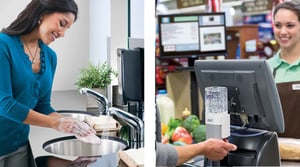 2) Promote proper and frequent hand hygiene by providing your staff and guests the necessary systems to wash and sanitize their hands throughout the day, especially after any of the above instances.
2) Promote proper and frequent hand hygiene by providing your staff and guests the necessary systems to wash and sanitize their hands throughout the day, especially after any of the above instances.
More than 80% of illnesses are transmitted by hands2 and one hand can infect over half of the staff in an office by lunchtime3. With each absent employee costing more than $2,600 per year4, businesses can significantly reduce costs associated with health care claims and absenteeism by providing proper hand care systems that are proven to reduce the spread of germs in an office by 74% and reduce absenteeism by 20-50%2.
Tip: Many businesses have found that customers perceive a display of hand hygiene signage and sanitizing systems as proof that their business cares about the health of guests and overall cleanliness. Place hand hygiene signage and freestanding, wall mount, or rail mount hand sanitizing systems in high traffic areas (e.g. main entryways, elevator lobbies, check-out registers) to act as a visual reminder to staff and guests to wash and sanitize their hands.
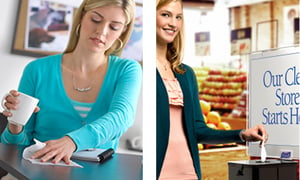 3) Frequently sanitize surfaces with disinfectants or other cleaners to sanitize high traffic and public surfaces including those listed above, and personal surfaces, such as desks and phones. As a business, make sure your staff has the proper cleaning supplies and tools to effectively sanitize surfaces.
3) Frequently sanitize surfaces with disinfectants or other cleaners to sanitize high traffic and public surfaces including those listed above, and personal surfaces, such as desks and phones. As a business, make sure your staff has the proper cleaning supplies and tools to effectively sanitize surfaces.
The right tools can effectively prevent the spread of germs, as well as reduce labor costs and increase productivity. Try an all-surface, hospital-grade or EPA registered disinfectant cleaner or wipes that allow you to use only one product to sanitize multiple surfaces throughout your business.
Also be sure to train your staff on the difference between cleaning and sanitizing. Cleaning removes food, dirt, and other types of soil from a surface. Sanitizing reduces the number of pathogens and microorganisms on that clean surface to safe levels. To be effective, cleaning and sanitizing must be a two-step process.
Create a healthy environment for your staff and guests, and reduce absenteeism with a complete hand care system.
Or contact us to place an order.
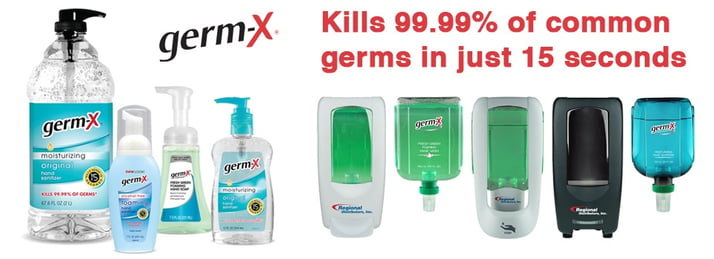
1. http://journals.lww.com/joem/Fulltext/2016/06000/Impact_of_a_Comprehensive_Workplace_Hand_Hygiene.25.aspx
2. National Center for Preparedness, Detection, and Control of Infectious Diseases (NCPDCID) and National Center for Zoonotic, Vector-Borne, and Enteric Diseases (NCZVED)
3. Dr. Charles Gerba, University of Arizona, Germ Warfare in Your Facility Seminar, September 2014
4. CIRCADIAN’s Shiftwork Practices 2005






